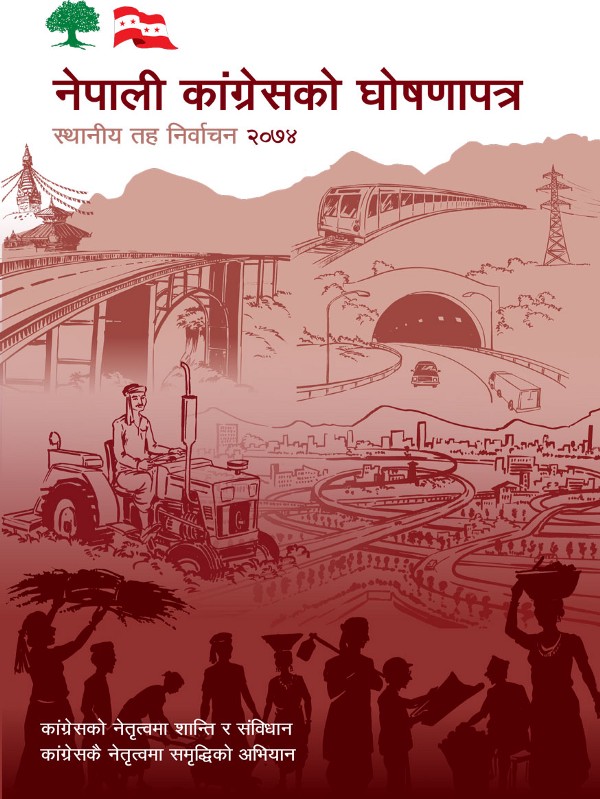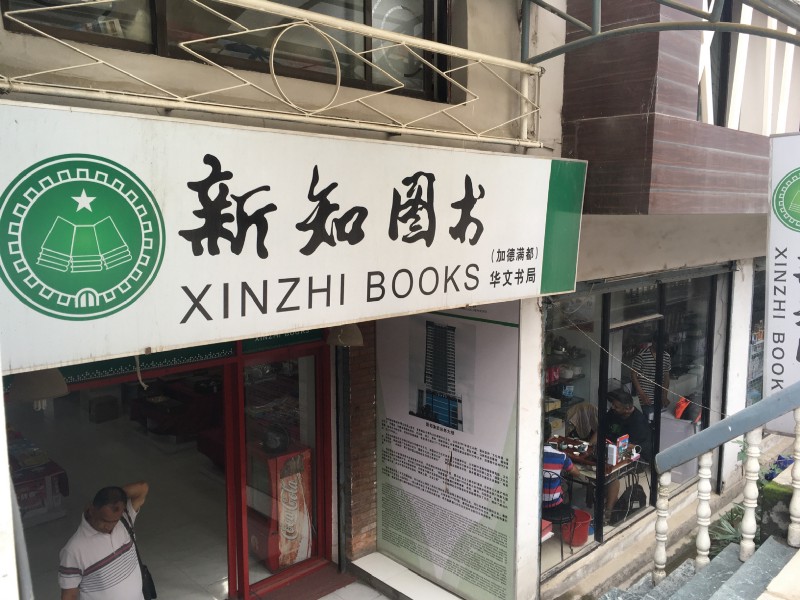Nepal’s International Airport, even before Kathmandu gets a chance to introduce itself, a large flex-banner advertisement yells from the ground-floor landing: ‘shop from the ‘Made in China’ mall, only one-hundred-and-fifty kilometres away from Kathmandu.’ The mall called Gyidragon, which is a cross border-shopping platform working out of Gyirong port in China, holds special significance for the people of Nepal. During the Madhesi blockade of 2015, supplies were sent from the port to ease the distress in the country. The drift of this message is that distances between Nepal and its northern neighbour have collapsed: goods can travel either two days by road, or two days by train and China is willing to move mountains to come closer.
This high decibel propaganda is not just limited to a random hoarding but is overwhelmingly visible in the discourse and the manner in which the Chinese are pushing hard to enlarge their control and influence in the landlocked Himalayan country. Nepal’s decision to sign the Belt and Road Initiative (BRI) of the Chinese government is whetting their appetite for sneaky expansion and spread of their hegemony. They are taking advantage of the schism in the Nepalese society between the people of the hills and the Madhesis, the people of the plains and the angst towards India to push for their geostrategic objectives.
Lately, the Nepalese, who have been promised top quality infrastructure, are getting wary about the implications of the Chinese funds. Questions about the impact of Chinese loans for infrastructure and on issues of sovereignty can be heard in Kathmandu’s argumentative and engaged civil society.
Due to its geographical position, Nepal has always lived in the shadow of two Asian powers, always hoping to play one against the other to get a better deal. From time to time, Nepal has flirted with China but always remained engaged with India. One example of this was the building of the Kodari highway, which linked Nepal to Tibet after the reinstatement of King Mahendra, who in retaliation moved closer to the north. However, this bonhomie did not last long, as narrated by Aditya Adhikari, in his book, The Bullet and the Ballot Box: The Story of Nepal’s Maoist Revolution. Adhikari writes about how China indoctrinated Nepali workers-involved in road construction- by teaching the values of Maoism. They were given Mao badges and ‘it was claimed, were forced to salute Mao’s portrait and chant slogans praising him before they received their wages. At another event, later in the year, the Chinese put up Mao’s photo above that of King Mahendra which irked the monarchy and caused demonstration outside the Chinese embassy. The rise of the Maoists in Nepal may seem disconnected with China, but any student of history will reveal that their introduction in the politics of the Himalayan kingdom provided the environment for their growing enlargement.

If China and Nepal’s relations have not grown all these years then it has more to do with geography, ethnicity and religious and political ties it shares with India. Nepalese have made light of the Chinese aid that they received in the last seven decades. Instead, they have given precedence to cultural closeness with India and a common language that allows greater opportunities for Nepali people. As Adhikari wrote in his book: “The Indian influence far exceeded the Chinese and various leaders in Nepal dreamed– and continue to dream to this day– of using Chinese support to counterweight Indian domination”. For successive Indian governments, this has been a trying exercise to ensure that the demands and expectations of the Nepalese people and leadership are met.
This seems to have been changing since 2008, but it gained strength after a five-month long blockade imposed by Madhesis in 2015 who were protesting against the failure of the new constitution to accommodate their aspirations. China building on the differences between the people of the hill and the plains whipped up a new form of ultra-nationalism under Prime Minister Khadga Prasad Oli.
What gave the ultra nationalists the strength to question a relationship founded on shared culture, religion and robust economic linkages?
During the Madhesi blockade, Chinese cleverly used the ‘symbolic’ train to Gyirong that carried fuel during this period to convey to the Kathmandu-elite that geographical distance between them was easily surmountable. In a display of foolhardiness, the government of Oli created an impression that India was being unfair and partisan towards Madhesis and was hurting their national interest. This propaganda disturbed the political balance in the country.
the traditional relationship between Nepal and China can broadly be broken down into three distinct phases: the first between 1955–89 was to help build infrastructure, after 1990 was to reduce Nepal’s reliance on India, and lastly their objective was to encircle India.
Though there is no denying the fact that the growth of China and its renewed assertion in the world is distinctly different from what has been seen before. This expansion poses new and different challenges to Nepal and India. According to a scholar, Satish Kumar, in his paper on India-Nepal and China in the Indian Defense Review, the traditional relationship between Nepal and China can broadly be broken down into three distinct phases: the first between 1955–89 was to help build infrastructure, after 1990 was to reduce Nepal’s reliance on India, and lastly their objective was to encircle India.
In its own way, this is playing out at a rapid pace. The old narrative has changed and the new phase of the Chinese relationship with Nepal is being driven by its own imperial ambitions, which is markedly different from their earlier involvement in the country. As some of the Nepal watchers have pointed out that this time around China is more determined to gain control of the Nepalese politics and economy than ever before. The high-speed railways and the highways that are part of the BRI are all means to leverage connectivity projects for strategic purposes. Those Nepalese who can draw a comparison between the two systems are quite candid about what this would really entail. The head of a think tank based out of Kathmandu said: “If both India and China were pins, the latter would be a headless pin; once inside it will be very difficult to get it out”.
Enter the Dragon
“The China of today is very different from that of twenty-years-ago. Things have changed dramatically: China is no longer just an investment destination, but it has also become a major investor in other countries”, says CK Lal, author, academic and Madhesi activist, while talking to Hardnews. “In 1989–90, when India, imposed a blockade, which was worse than two years ago; we had requested China to help, but they said no. Back then, they were a different country: they were inimical to the West, they had issues of their own regarding human rights and their economy was in shambles.’ In 2015, things were different, he said, this time when we approached them for aid, they came, not with a lot, but with enough to give our morale a boost.”

In Kathmandu and rest of Nepal, China is seen, both, with awe and fear. In the manifestos of the political parties, most notably the Nepali Congress, there are images of the monorail, the highways, and the train. Incidentally, all of them are based on the promises that China has made. How did it spring up? Rumors in Kathmandu suggest how the Chinese embassy is aggressively engaging with Nepalese politicians. This is unusual. In the past, they would not deal with them as long as their limited interests were served.
Post blockade, political parties are vying with each other to ingratiate themselves with the Chinese. There are hints that the Chinese have been quite magnanimous in taking care of the needs of these politicians. To buttress the impression that they are inexorably heading to attain the commanding heights of the Nepalese economy- the Chinese have increased their assistance in practically every sphere. In the last elections, they also paid a token amount for its smooth conduct.
While imports from India still remain the highest, around 60 per cent, the Chinese are now giving handouts to Nepal.
In 2016–17, according to reports, Chinese investments have outstripped that of any other country. They are funding 108 active projects worth NPR 29.8 billion. In comparison, India only has eighteen projects amounting NPR 8 billion. In short, there has been a seventeen times increase in Nepal’s imports from China since 2006. “The rise in imports from the north are tied to our country’s trade deficit; China provides cheaper goods which are now flooding the markets in the country,” says Kapil Shrestha, a human rights activist, political science professor and member of Nepal’s election observation committee. This is an important thought for a landlocked country whose economy has suffered due to years of instability aggravated by the adverse balance of payments.
This rapid spread in every aspect of the economy is worrying for many. People are slowly waking up to the harsh reality that there are no free lunches when it comes to China. All of these developmental projects come at a cost.
“Nepal is development hungry; years of instability have left the country wanting to move forward. Now for the first time in seventy years, we find ourselves in a place where we can actually think of our own interest,” said Rajan Bhattarai, a member of parliament from the Communist Party of Nepal (Unified Marxist-Leninist). “We will look out for what is in the country’s interest and we will take what is good for us,” he continued.
“While India has historically behaved like a colonial power, bound by babu-dom, bullying and interfering; China is an imperial power. What this means is that China requires absolute and immediate compliance,” said Dr Hari Sharma, an eminent political scientist and former advisor to the Government of Nepal, “If China wants something it will get it, and we as a small nation can only humbly request for what we need.”
Sharma in his most recent writing in local papers asks an important question of ‘How much does Nepal know China?’ It seems very little.
The above question takes an urgent form because China is now fast becoming the face of development. With little more than $8 billion pledged in Foreign Direct Investment (FDI) in Nepal, they have projects in almost every sector ranging from agriculture, tourism, manufacturing and hydropower. They are building two airports in Nepal one in Pokhara and the Bhairahawa International Airport in Lumbini –mostly due to the lethargy of the Indian government. Other than these, China is helping in the construction of two large hydropower projects on Budhi Gandak and West Seti meant to help realise Nepal’s dream of complete energy independence to allow it to export it to India or China. It is also building a monopoly in the construction business in Kathmandu and other cities. According to Shrestha, “There has been a steady takeover by Chinese construction companies in Kathmandu, all houses that are large and well-built are by them.”
This rapid spread in every aspect of the economy is worrying for many. People are slowly waking up to the harsh reality that there are no free lunches when it comes to China. All of these developmental projects come at a cost. There are conditions that Chinese capital carries. they determine every aspect of the project. “They tell you who works, how the money is used, they prefer to bring in their own people and technicians on the projects. Even if the dam, road or project cracks up- you have to go back to them to have it fixed,” said CK Lal. According to reports, in seven hundred projects the Chinese have proposed to hire only 32,932 local workers, which is nearly half of the 63,600 that India has proposed to hire in around six-hundred projects. Quite evidently, the Chinese will bring in their own workers, as they have done in Africa and in other parts of the world.
Kapil Shrestha fears that China could use development as a means to undermine sovereignty. It was reported that the Chinese companies wanted to place China’s PLA troops at the dams to ‘protect’ their investments. This proposal was shot down by the Nepali Government. Even in Sri Lanka, as a part of the Hambantota Port Development projects, they pushed for getting their troops to protect the harbour and port where they are, but the Sri Lankan government denied. However, it is in Djibouti that they have been able to build a military base.
How will China and India react to Nepal if there is another catastrophe like a blockade? Civil society activists in Kathmandu believe that Nepal would know how to deal with New Delhi but not Beijing. “We travelled to New Delhi and were able to mobilise politicians and civil society activists to support our cause. We had seminars at the IIC in New Delhi and Nepal’s friends stood up in parliament and raised questions about the validity of the blockade. Who do we go to Beijing? We have no one! Tatopani Highway, a major arterial route for trade between us and them has been blocked for two years! We are at the receiving end of an undeclared blockade by China,” said Uddhav Pyakurel, an academic and activist.
Business not as usual
In the words of a political analyst in Kathmandu, there are three visible areas of Chinese growth in Nepal. More and more Chinese tourists are now coming to Nepal– they have been given five-month visas on arrival. Secondly, there are a growing number of small traders — mainly the people of the Han community of China, who own a number of restaurants. The small traders are taking over tourist areas setting up restaurants. The first wave of Chinese investment comes in the form of restaurants and massage parlours. This is true about Ethiopia, Djibouti and other African countries, where the Chinese have established a stronghold. Lastly, there has been an increase in the number of political, business and military delegations that are coming into the Himalayan nation. The catalyst for this, according to them, is that China with the largest reserve of foreign exchange makes offers that small development challenged countries can’t refuse.

Thamel is Kathmandu’s tourist district made famous by the hippie generation. Ram, a small restaurant operator here, is a worried man. “Wherever you go the Chinese are setting up big restaurants, and they are buying out small Nepali traders and restaurant owners. We can’t do much. What is worse is we do not benefit from the spike in tourism”.
There are others that anticipate some good profit. “There is a lot of money to be made from doing business up north, and Newari businesses are now lining up. Even Brahmins, other than the traditional Newari caste, are now lining up to do business with China. As all businesses in China have a state component, there is a lot of money to be made. India is not in the reckoning,” said CK Lal. This information has found corroboration in the sheer number of Chinese business delegations coming to Nepal and signing MoUs.
How will China and India react to Nepal if there is another catastrophe like a blockade? Civil society activists in Kathmandu believe that Nepal would know how to deal with New Delhi but not Beijing.
Nepal China Chamber of Commerce and Industry (NCCCI) has been busy receiving many such delegations. “They come and make tall claims of investing in our country. When we sit in a room and talk business, the Chinese are eager to come and invest in the country but afterwards, we see no results,” says Rajesh Kazi Shrestha, chief of NCCCI.
There is a fascination for the efficiency that the Chinese bring in to trade. “Goods take nearly four-days to come from India, if not more. China showed us that it is possible in two,” said Dipak Gyawali, former minister of Water Resources (2002/2003) and Chair of the Nepal Water Conservation Foundation (a non-profit). Nepali businesses are happy that they are getting an outlet other than India.
Myopic Policies and No Home Work
Chinese expansion in Nepal has brought to the fore the manifest ill preparedness of the entire Nepalese political establishment to deal with a big power. “Nepali leaders can be easily duped,” said Gyawali. Another commentator felt that the ‘cartel of five parties’ that run Nepal have a myopic view and only bothered about their self-interest.
Chinese manage such misgivings by backing the party in power. Earlier they were close to the monarchy as their main agenda was to keep Nepal stable to ensure tranquillity in Tibet.
“Twenty-five years of ups and downs, ten-years of the people’s war and now eight-years to write the constitution and nearly a dozen Prime Ministers after, there is little or no long term strategy in both Nepali foreign policy or in the relations with China,” said a political commentator working for an international think tank. It is a common belief that the political instability and the musical chairs of Prime Minister and the power sharing have only worsened the situation in the country. This ‘lack of a plan’ is being couched in a larger national interest. “This is why they got bullied into signing the Belt and Road Initiative,” said this commentator.
Those lobbying for increased Chinese investment have been trying to show it as a benign neighbour, unwilling to intervene in the internal politics of the country — adhering to the policy signed in 1955. While a large section of the society, including Kazi Shrestha, are overjoyed about the prospects of greater connectivity, there are many others who are not enthusiastic about their landlocked country being reduced to a highway. “The train line is only to get closer to India and we are being used as transit,” said Gyawali, “They want to come closer to Kannauj.” According to Hari Sharma, Nepal is only of use to access the South Asian market, “We have no market, we have no demand. One container of the train will be enough.” Even the train that China has promised to build will be a luxury train not meant for the average Nepali.
Chinese manage such misgivings by backing the party in power. Earlier they were close to the monarchy as their main agenda was to keep Nepal stable to ensure tranquillity in Tibet. They achieved this goal as Nepal accepts the ‘One China Policy’, secondly, by their steady influence over the political establishment, they have made it difficult for Tibetans to buy homes or find jobs in Kathmandu or elsewhere. Behind doors, they use their muscle power blatantly as they have no faith in the political establishment of the country.

There are also rumours that China played a role in the cabinet formation by getting some of their favoured ones, Krishna Bahadur Mahara, to stay in the government despite it being the Nepali Congress’ government. Now, the Chinese lobby has got so strong that they were able to quiet India down.
This does not augur well for the Himalayan Country and its recent tryst with democracy. The Chinese system is very different from that of India– one that they are used to. “The new Chinese model is a counter to the democratic model, it is a different system,” said Bahadur Thapa. It is an open secret that China does not fancy the federal system, one that gives rise to much confusion. A Political Commentator and former editor of a local magazine, while speaking to Hardnews said, “Beijing prefers stability and structure, the chaos of South Asia might not work for them.”
Chinese preferred monarchy as there were fewer people to keep happy, but now they have found a way to manage the chaos of this Himalayan state. The chatter of doubts and misgivings are now beginning to emerge in South Asia as full implications of the Chinese investment in CPEC or Hambantota are revealed. Only time will tell what it would mean for those who joyfully accepted Chinese investment-development or debt trap?
Budhi GandakChinaForeign Direct InvestmentKhadga Prasad OliMadheshisNepalNepal China Chamber of Commerce and IndustryNepal Water Conservation FoundationNepal’s Maoist Revolution